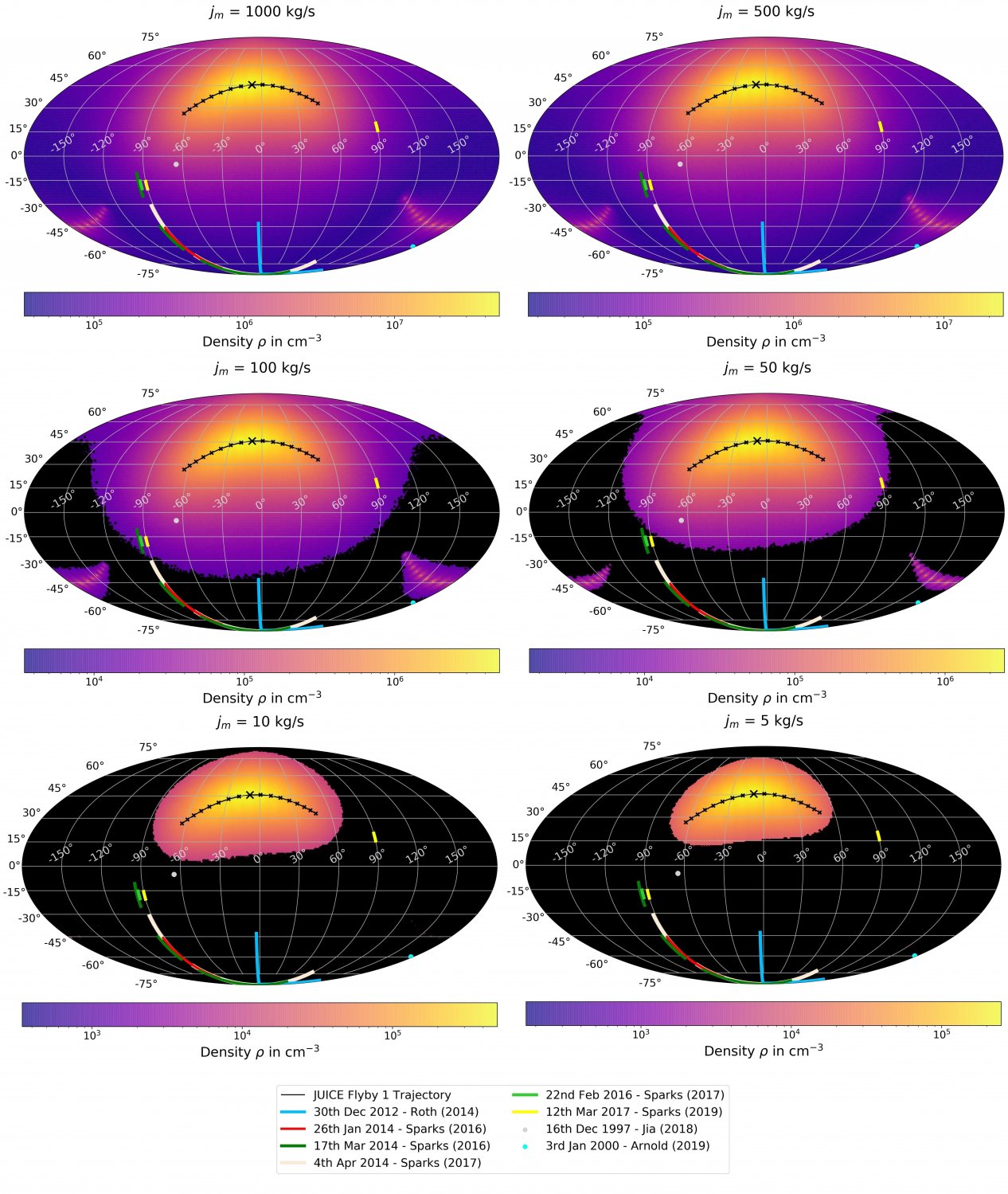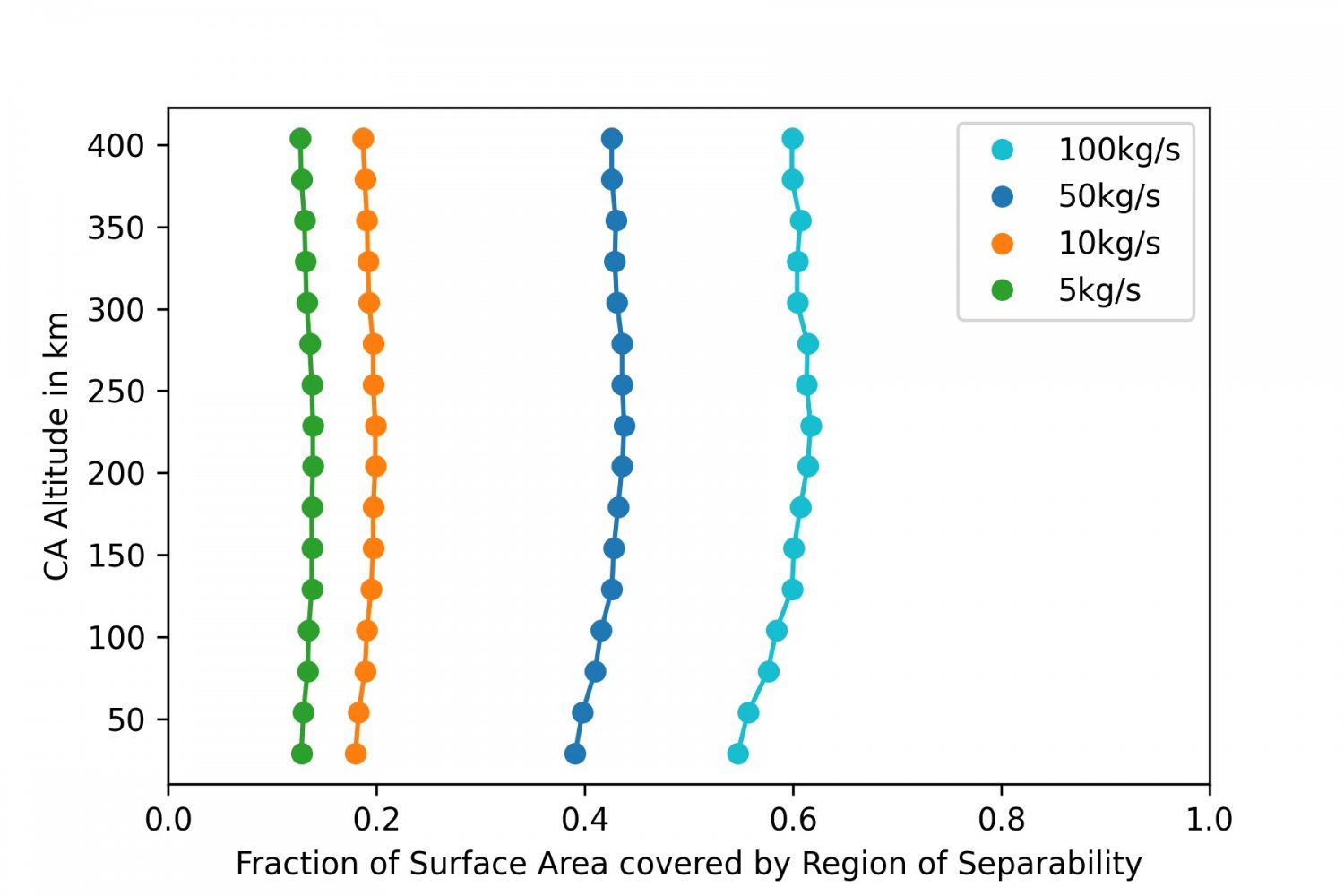Abstract
Positive and negative ion velocities are derived in directions parallel and perpendicular to Cassini’s trajectory through Titan’s ionosphere, alongside spacecraft potentials, using in-situ measurements from sensors in the Cassini Plasma Spectrometer (CAPS) instrument. Negative ions are detected by the Electron Spectrometer (ELS) while positive ions are detected by the Ion Beam Spectrometer (IBS). Preliminary analysis indicate that the magnitudes of these velocities are up to several hundred m/s, higher than previously reported in-situ measurements, but comparable to ALMA measurements of prograde neutral winds up to 390 m/s. These ion velocity measurements add to the understanding of high-altitude ion and neutral winds at Titan, aiding future investigation into this dynamic system.
Introduction
Pre-Cassini models of Titan predicted thermospheric winds of up to 60 m/s1, however, from Cassini-Huygens and ALMA observations there have been indications of superrotation in the thermosphere/ionosphere, with neutral wind speeds up to 390 m/s2. Previous in-situ measurements have measured positive ion velocities along Cassini’s trajectory(along-track), finding velocities up to 260 m/s. Positive and negative ion velocities perpendicular to Cassini’s trajectory (cross-track) have been previously estimated to be of similar magnitude to the along-track velocities3.
The Cassini Plasma Spectrometer (CAPS) Electron Spectrometer (ELS), CAPS Ion Beam Spectrometer (IBS)4 and the Radio & Plasma Wave Science (RPWS) Langmuir Probe (LP)5 instruments on Cassini can derive values for the spacecraft potential that arises from spacecraft charging. However, there are discrepancies in the magnitude of the derived spacecraft potential between the instruments. Derived spacecraft potentials of Cassini in Titan’s ionosphere are in the range between 0 and -3.5V3, with ELS-derived potentials typically being more negative than the Langmuir probe6, while IBS-derived potentials are more positive3. Although differential spacecraft charging can explain the discrepancy between the LP and the CAPS sensors, it cannot explain the discrepancy measured between the CAPS sensors.
Here we derive spacecraft potentials and along-track ion velocities from the energies of the observed ions and attempt to derive cross-track ion velocities by utilising the rotation of the CAPS instrument.
Methodology
The CAPS instrument consists of three electrostatic analysers, which measure the energy/charge ratios of ions. In this study, we utilise data from CAPS ELS and IBS which observed negative and positive ions respectively. In Titan’s ionosphere, ions are observed by CAPS as a supersonic beam in the instrument frame, therefore the energies of the ions are related to the ions’ mass, the spacecraft velocity, the along-track ion velocity, and the spacecraft potential. Fits are applied to positive and negative ions, to derive values for the along-track ion velocity and spacecraft potential.
Cross-track velocities are perpendicular to Cassini’s trajectory. These velocities cause the ions to be detected from a direction which is a small angle away from Cassini’s trajectory. This angle can be measured due to the actuation of CAPS across the spacecraft’s velocity vector.
There are several sources of uncertainty in this methodology, including instrumental, spacecraft-plasma interactions and Titan’s ionosphere itself. Examples of instrumental effects include uncertainty in the actuator position and the energy resolution of the CAPS sensors. Spacecraft interaction uncertainties caused by the spacecraft include differential spacecraft charging and particle trajectories being deflected by the spacecraft potential. Lastly, Titan’s ionosphere itself, or electric fields due to its plasma interaction, may impact the measurements. Electric fields up to 3 µV-1 have been detected in the ionosphere8, which would separate positive and negative ion trajectories. The methodology was adapted to mitigate these effects in several ways.
Results
Positive and negative ion velocities are measured both along Cassini’s trajectory (along-track) and perpendicular to it (cross-track). Proportionality is observed between the positive and negative ions for the derived along-track and cross-track velocities, which agrees with the expectation of collisional coupling between the positive and negative ions and the neutrals.
The magnitudes of these velocities are up to several hundred m/s, higher than previously reported from in-situ measurements, but comparable to ALMA measurements of prograde neutral winds of up to 390 m/s2. Early analysis has shown no longitudinal or altitude dependence for the derived winds, although this is constrained by the limited sampling available. A slight latitudinal asymmetry is observed, which would be consistent with neutral wind findings of a stronger zonal wind in the southern hemisphere9.
References
1. Rishbeth H., R.V. Yelle et al., Dynamics of Titan’s thermosphere, P&SS, Vol 48, Issue 1, 2000, doi:10.1016/S0032-0633(99)00076-8
2. Cordiner, M., E. Garcia et al., Temporal Variability of Titan's High-Altitude Zonal Winds Detected using ALMA, 14th Europlanet Science Congress 2020, doi:10.5194/epsc2020-424
3. Crary, F.J., B.A. Magee et al., Heavy ions, temperatures and winds in Titan's ionosphere: Combined Cassini CAPS and INMS observations, PSS, Vol 57, Issues 14–15, 2009, doi:10.1016/j.pss.2009.09.006
4. Young, D. T., J. J. Berthelier et al., Cassini Plasma Spectrometer Investigation, Space Sci. Rev., Vol 114, Issue 1-4, 2004, doi:10.1007/s11214-004-1406-4
5. Gurnett, D. A., W. S. Kurth et al., The Cassini Radio and Plasma Wave Investigation, Space Sci. Rev., Vol 114, Issue 1-4, 2004, doi:10.1007/s11214-004-1434-0
6. Desai, R. T., A. J. Coates et al., Carbon Chain Anions and the Growth of Complex Organic Molecules in Titan’s Ionosphere, Ap. J Letts, Vol 844, Issue 2, 2017, doi:10.3847/2041-8213/aa7851
7. Cravens, T. E., M. Richard et al., Dynamical and magnetic field time constants for Titan's ionosphere: Empirical estimates and comparisons with Venus, JGR, Vol 115, Issue A8, 2010, doi:10.1029/2009JA015050
8. Ågren, K., D. J. Andrews et al., Detection of currents and associated electric fields in Titan's ionosphere from Cassini data, JGR, Vol 116, Issue A4, 2011, doi:10.1029/2010JA016100
9. Vinatier, S., C. Mathé et al., Temperature and chemical species distributions in the middle atmosphere observed during Titan's late northern spring to early summer, A&A, Vol 641, 2020, doi:10.1051/0004-6361/202038411




